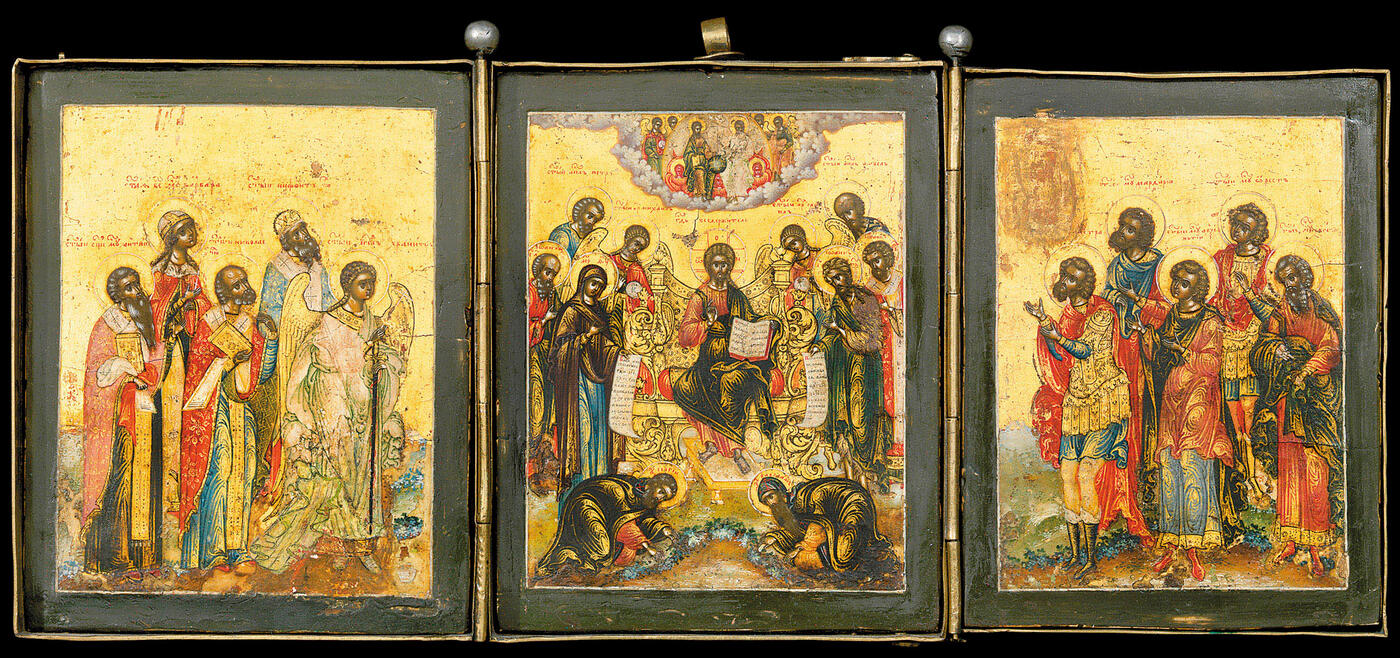MacDougall's Russian Art Auctions 8-9 June 2011
8 June 2011

610. A TRAVELLING TRIPTYCH OF THE SAVIOUR OF SMOLENSK AND SELECTED SAINTS WITH THREE SILVER-GILT OKLADS
7,500-10,000 GBP
ROMANOV-BORISOGLEBSK, BEGINNING OF THE 19TH CENTURY, OKLADS STAMPED WITH MAKER'S MARKS A.A IN CYRILLIC, MOSCOW, 1850, 84 STANDARD.
Extended 12 by 28.5 cm., closed 12 by 9.5 cm.
This finely-painted folding triptych with rare iconography, is a
unique artefact of Old Believer culture from Romanov-Borisoglebsk
on the upper Volga, renown for its adherence to the old ways.
The triptych is based on the traditional deisis composition, with
saints bowed in prayer towards a central figure of Christ
Pantocrator enthroned. The combination of saints suggests the
triptych was an individual commission.
The central panel portrays typical pairings of saints; the apostles
Peter and Paul, the archangels Michael and Gabriel, the essential
deisis participants – the Mother of God and John the Baptist –
with John the Divine and St. John Chrysostom ranked behind
them and Sergius of Radonezh and Varlaam Khutinsky
prostrated before them, all of whom form, together with Christ,
the “Saviour of Smolensk” composition.
On the left panel, are the holy martyr Antipas of Pergamon,
Nicholas the Miracle Worker, a Guardian Angel, the Great
Martyr Barbara and Bishop Niphon of Cyprus. On the right
panel are the martyrs Eustratius, Auxentius and Eugene, with
Mardarius and Orestes. This reproduces the rare iconography of
Five Martyrs of Sebaste, commemorated on 13th December.
These martyrs were especially revered amongst Old Believers,
for whom the martyrology of early Christianity was close to
their hearts and thus reflected in their icon painting. Our triptych is a further example of this aspect of Old Believer culture.
Of note, are two other saints on the triptych commemorated in
December – the Great Martyr Barbara (4th December) and
Bishop Niphon (23rd December). This choice perhaps reflected a
particular wish of the commissioner, for whom personal sufferings
were connected with December. The inclusion of two Johns –
John the Divine and John Chrysostom – may also be significant.
Stylistically, the triptych’s qualities speak of its origins on the upper Volga. The special artistry of the painting techniques employed for the faces, the intricate garment folds, the armour,
wings and throne with their gold decoration, the copious ornamental patterning and the rosy, pearl-grey palette, all suggest this
folding triptych to be from Romanov.

Notes on symbols:
* Indicates 5% Import Duty Charge applies.
Ω Indicates 20% Import Duty Charge applies.
§ Indicates Artist's Resale Right applies.
† Indicates Standard VAT scheme applies, and the rate of 20% VAT will be charged on both hammer price and premium.